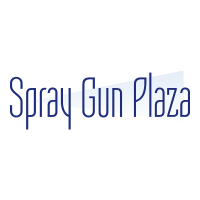Glossary of Spray Gun Related Terms
If you are new to the spray gun world and are confused by some of the terminology, this is the page for you! Check out our simple definitions for these complex terms.
Keep in mind that the terms spray gun, paint sprayer, paint gun and paint spray gun are all terms that are used interchangeably.
HVLP:
What is an HVLP Paint Sprayer? HVLP stands for High Volume Low Pressure
HVLP spray guns can be used with either compressors or turbine systems.
Turbine systems: This is the machine to which the spray gun must be connected in order to disperse paint.
The motor inside the turbine box creates the power to push the air and the coating through the paint gun. Turbine systems are portable and do not require a waiting period to fill up before use. Compressors stop working for a period of time if/when they run out of air.
Turbines provide a continuous flow of warm, dry air with no water. For this reason, there is no need for a regulator or moisture trap.
Turbine Filter Kits: These trap dirt and contaminants from the turbine box and keep the air clean and particle-free. Filter kits should be cleaned and replaced regularly. One filter kit consists of one pair of filters and one pair of pre-filters.
Filter Stand: A metal stand in which a cone filter is placed over a siphon feed cup or pressure pot to trap any dirt, particles or lumps before spraying.
Click here for filter stands.
Gravity Feed: A gravity feed cup attaches to the top of the spray gun. This allows the paint to drip down (being pushed by gravity) into the gun where it is then dispersed. Some gravity feed cups may be pressurized.
Siphon Feed: A siphon feed cup attaches to the bottom of the spray gun. A small hose attaches the cup to the gun through the valve stem and siphons the paint up into the gun.
- Valve Stem: This is a part that is inserted into a small opening typically found on the side of the paint gun. This valve is used with a small pressure hose (aka Air Feed Tube) and a Check Valve to pressurize the cup.
Click here for valve stems.
- Pressure Hose or Air Feed Tube: This is the small hose or tube that connects the cup to the valve stem.
- Check Valve: A check valve is a small disc in the middle of the pressure hose for pressurizing cups. These are used with both siphon feed and pressurzied gravity feed cups.
Click here for check valves.
- Pressure Pot: Pressure pots (also known as pressure cups) are the most common type of siphon fed cups. They attach to the bottom of the spray gun via a cup lid assembly with a pressure hose, check valve and valve stem.
Whip Hose: The Whip Hose, also referred to as the Flex Hose, is a 4-foot hose added to the end of the turbine hose where the sprayer is attached. The purpose of this piece is to allow the painter more flexibility in moving the sprayer around.
Viscosity: This refers to the thickness of the paint or material going through the sprayer. Viscosity can be measured using a viscosimeter or Zahn cup.
Viscosity is an important part of deciding which stage turbine and what size atomizing set are best for your project. As a general rule, high viscosity materials require a turbine with more stages as well as a larger size atomizing set (aka needle, nozzle and air cap). For example. latex paints tend to be thicker and will require at least a Stage 4 Turbine.
Atomizing Set: This is the term that refers to the combination of a needle, nozzle and air cap. These items are each defined below. For more detailed information on these including how to determine what size is best, see the article below the products here.
- Needle: The needle is the long, thin part that gets inserted into the sprayer. It usually runs the length of the spray gun.
- Nozzle: The nozzle goes over the tip of the needle. The size of the nozzle typically corresponds to the size of the needle
- Air Cap: The air cap screws in place above the nozzle and holds the pieces into place. This must also correlate to the size of the needle and nozzle.

Bleeder Gun: this is a type of sprayer that has a continuous flow of air through the air cap. Click here for a more detailed comparison of bleeders vs non-bleeders.
Bleeder Valve: this is an adapter that allows for a non-bleeder paint gun to be used with an older turbine system not originally designed for this use. This can also be called an air relief valve.
Click here for bleeder valves.
Turbine Blower: this is a tool that attaches to the end of the turbine hose that works efficiently at removing dust, dirt, particles and other contaminants from your work area.
Click here for turbine blow off tools.

Please feel free to request other definitions or contact us for help in general by emailing info@spraygunplaza.com or calling us at 858-722-1135.
Content last updated on 5/24/21.
